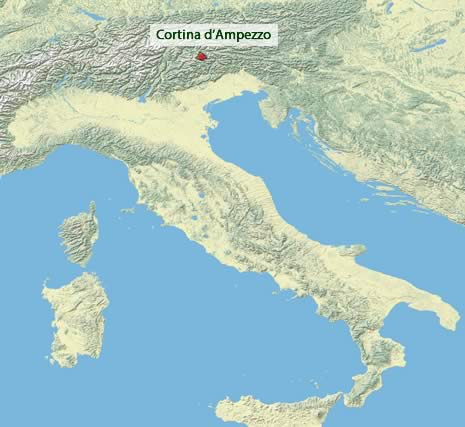Map of Cortina d'Ampezzo

Cortina d'Ampezzo is located in northeastern Italy, in the province of Belluno, Veneto region.
Using the interactive map above, you can find the address or attractions that you are looking for in the area of Cortina d'Ampezzo (Italy) and the itinerary you have to go there. To find an address, simply zoom in (using the +/- buttons placed at the bottom right of the map) to a scale where the names of the streets and the exact location of the hotels become visible.
- Latitude and longitude:
- 46°32′00″N 12°08′00″E
- Coordinates:
- 46.538056,12.137222
- Geo URI:
- geo:46.538056,12.137222
- Zip code:
- 32043
Interactive map of Cortina d'Ampezzo: terrain view
The territory of Cortina d'Ampezzo stretches from Falzarego Pass to Tre Croci Pass in the Ampezzo Valley (Italian: Valle d'Ampezzo also known as Conca Ampezzana) and is crossed by the Boite River and its tributaries. Elevations range from about 1,200 m above sea level, in the center of Cortina, at the bottom of the valley, to a maximum of 3,244 m at the top of Tofana di Mezzo peak.

The Ampezzo Valley was the basin of a quaternary glacier and is a natural amphitheater surrounded by the Dolomites. The rocky walls of the Dolomites form a splendid crown around the town, and Cortina d’Ampezzo, often called the Queen of the Dolomites, is a dream destination for mountain lovers.
Cortina is surrounded by majestic mountains such as:
Tofane (west);
Pomagagnon (north);
Cristallo (northeast);
Faloria and Sorapis (east);
Becco di Mezzodì, Croda da Lago and the Nuvolau group (south).
Cortina d'Ampezzo is divided into 6 subdivisions called sestieri (Sestieri d'Ampezzo): Alverà, Azon (Azón), Cadin (Ciadìn), Chiave (Ciàe), Cortina, Zuel (Śuèl). The names written in parentheses represent the names in the Ladin language (Ladinia), the local dialect. Sestieri (from the Italian word sesto, or sixth) were administrative subdivisions of Italian cities divided into 6 districts. Today, they are no longer used as administrative subdivisions, but are intended to represent local and traditional historic communities.
Go to top